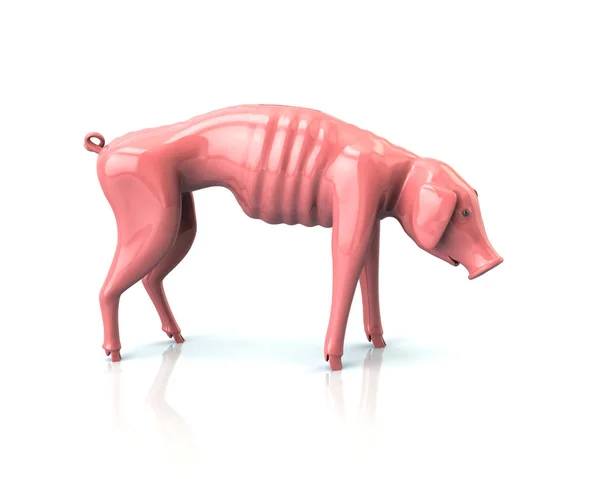
Some of us have experienced our sows and gilts as being very drawn during and after feeding their piglets. The causes have been diagnosed as inadequate feed during lactation, farrowing house being too hot or is due to underfeeding during pregnancy. This effects weight loss and anoestrus (poor return to season).
Causes
The condition results classically from a combination of parasitism – one organism (called parasite) benefits at the expense of another organism usually of different species (worms or mange), low environmental temperatures and inadequate feed intake, particularly during lactation. Weight loss at this time may never be regained. Parasitism is less important when therapy is routinely carried out. In outdoor pig populations, low environmental temperatures are important.
Outdoor sows require at least 200 kg more feed per sow per year than indoor animals. Sow that are kept indoors during the winter cold months should be kept at 22°C and sows in moderate condition at 21°C. Lower temperatures may be tolerated in the presence of bedding. Temperatures below this require extra feed to maintain sow weight gain in gestation.
Feed intake is the most important cause. Feed intake may be affected by bullying, disease, a high environmental temperature in the farrowing accommodation, or an over fat condition at farrowing. Sows should be in condition score 3/4 or 6/10 (fat depth at P2 16-20 mm) at farrowing, which may fall to condition score 2-2.5/4 or 4/10 (fat depth P2 12 mm) after lactation. Unless these criteria are met, total weaning weight of the litter will be reduced, return to oestrus will be delayed and egg numbers will be reduced to give small subsequent litters.
Clinical signs
In extreme cases, being abnormally thin or weak may occur in 30-90% of sows and boars in a herd, associated with hypothermia 36.5-38°C (97-100°F), depraved appetites, restlessness, apathy, and later, difficulty in rising. The skin may be dirty and greasy and there may be surface abrasions. As the condition progresses, failure to return to oestrus and permanent infertility may occur.
Where accurate individual feeding to condition is not practised and bullying occurs, individual animals in a group can be clinically affected. Less than optimal condition are frequently found in winter where temperature control is not practised. Suboptimal condition or even thin sows may be found during the recovery period from disease such as influenza and may be more extreme in lean breeds. Clinical signs of suboptimal condition include increased weaning to service intervals, small litters and low weaning weights. Piglets of sows in suboptimal condition may be restless and demand milk more frequently.
Thin sows may be identified by observation and systematic condition scoring of the herd. Ultrasound is particularly useful for quantitative measurement as scoring is more difficult in older animals due to their conformation. As sows should gain at least 12.5 kg body weight between parities, regular weighing can identify animals in sub-optimal condition. Pressure sores in sows at weaning also indicate poor condition.
Where gilt condition and nutrition in lactation is inadequate, the second litter is the same size or smaller than the first, and low number born may reflect overall sow condition at service. Extended weaning to service intervals and low weaning weights may be due to poor body condition. The causes of poor sow condition should be established. It should be established that feed of adequate quantity and nutrient density is being supplied to each individual especially during lactation and until implantation 10-14 days after service. Parasitism can be ruled out by inspection, by sampling for mange and faecal sampling (which some of you do) for worm eggs and coccidia. The influence of disease may be established by inspection, clinical examination or consultation of the recent history of the herd of the animals concerned.
Treatment and prevention
There is no treatment. The effects of thin sows on litter weaning weights can be reduced by supplementary feeding of the litter, whereby some of us have supplemented with sow replacement milk in the earlier days. The effects on numbers born may be reduced when sows or gilts are in poor condition by delaying service until the next oestrus. Ensure that adequate quantities of food of the correct nutrient density are given to all affected animals and that individual feeding is possible. Environmental temperatures should be restored to normal and anthelminthic or mange treatment should be considered.
Adequate feed intake during lactation and early pregnancy should maintain the weight of the sow and increase it by 10-15 kg between litters by increasing the energy content of lactating rations with fat or feeding three times daily during lactation. It may be necessary to weigh sows after weaning (for those of you that do not have scales please may I remind you that we have a “calculate the live weight” in the OSBPG tools section of our website) in order to ensure that adequate weight gain has occurred between lactations, to assign them to groups for feeding at an appropriate level through pregnancy or to feed individually to condition.


All reactions:
8Kathryn Green-Smith, Anita Withers and 6 others